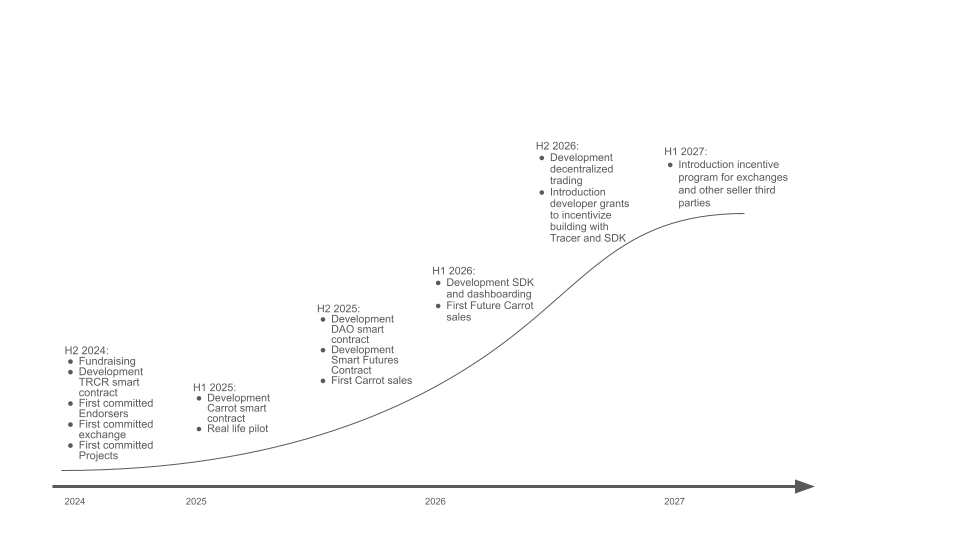4️⃣Market adoption
Tracer's go-to-market strategy is unique in the carbon removal market, focusing on empowering the long tail of suppliers and creating a vibrant ecosystem of financial products and services built around the Carrot smart contract. This approach differs from the "build it and they will come" strategy employed by many competitors, which has often failed to gain significant traction.
4.1 Empowering the supply side
Tracer's initial focus is on supporting the long tail of carbon removal project developers, as the current market is characterized by high demand for carbon removal credits but limited supply. By leveraging the Tracer DAO's treasuries, the ecosystem aims to empower these suppliers through:
Access to funding for new projects: Tracer's financial instruments, such as Carrot token futures, enable project developers to secure funding by selling carbon removal credits before they are delivered. This provides them with the necessary capital to start and scale their operations.
Easy access to buyers: Tracer enables project developers from every size to access a wide range of buyers, including those with high demand for carbon removal credits. This eliminates the need for intermediaries and enables suppliers to succeed in scaling their carbon removal solution and maximize their revenue potential.
Achieving cost-efficiency: Tracer helps projects achieve cost-efficiency by enabling them to scale their own projects. As carbon removal technologies scale, the costs are expected to decrease. For example, large-scale deployment of bioenergy with carbon capture and storage (BECCS) can reduce per-unit costs through economies of scale. Moreover, investment in technology innovation is crucial. Current costs for DAC can be high, but with continued development, these costs could drop to around $200 per ton of CO2. By providing project developers with access to funding and a wide range of buyers, Tracer empowers them to scale their projects and achieve cost-efficiency.
4.2 Attracting developers
In addition to supporting suppliers, Tracer actively incentivizes other developers with grants and tooling like APIs and SDKs to build products that leverage the Carrot smart contract. These products can facilitate the trading of carbon credits while ensuring traceability and liquidity. By fostering a diverse ecosystem of financial products and services, Tracer offers a unique DeFi (decentralized finance) proposition that sets it apart from competitors.
Some examples of financial products that developers could build on top of Tracer include:
Decentralized exchanges: Developers can create specialized decentralized exchanges for trading Carrot tokens and other carbon-related assets, providing users with a seamless and transparent trading experience.
Lending and borrowing platforms: Developers can build platforms that allow Carrot token holders to lend their tokens to others or use them as collateral for borrowing other assets, creating new opportunities for liquidity and capital efficiency.
Prediction markets: Developers can create prediction markets that allow users to speculate on the future price of Carrot tokens or the success of specific carbon removal projects, providing valuable insights into market sentiment and trends.
4.3 Incentivizing (re)sellers
To further drive adoption, Tracer incentivizes exchanges, agents, and other third parties to sell Carbon Credit products to both small and large buyers. Tracer can incentivize (re)sellers through:
Revenue sharing: These arrangements reward (re)sellers for bringing new buyers and suppliers to the ecosystem.
Marketing support: Providing marketing resources and co-branding opportunities to help (re)sellers promote Tracer carbon credit products to their customers.
Technical assistance: Offering technical support and training to help (re)sellers integrate Tracer's products and services into their existing platforms and workflows.
4.4 Roadmap
The roadmap for Tracer's development and adoption is designed to ensure the ecosystem's success in the rapidly evolving carbon removal market. As the ecosystem progresses through 2025 and 2026, the emphasis shifts towards expanding the ecosystem and introducing new features and functionalities. This includes the development of the Carrot smart contract, the creation of a real-time pricing model, and the introduction of the First Future Carrot sales and an incentive program for exchanges and other seller third parties. By 2027 and beyond, Tracer aims to have established itself as a leading player in the carbon removal market, with a thriving ecosystem of suppliers, buyers, developers, and partners.

Last updated